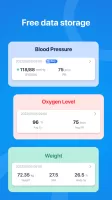ViHealth - Connect & track health
Discover your health journey by connecting devices, tracking data, & storing history effortlessly with this user-friendly app.

- 2.75.13 Version
- 1.0 Score
- 244K+ Downloads
- In-app purchases License
- 3+ Content Rating
The ViHealth APP is compatible with your Viatom devices.
It allows you to access historical data from those devices:
-Establish a connection with the device using Bluetooth;
-Retrieve data from the device;
-Display and save the historical data.
Important: The information offered by this App is not meant for medical use; always seek advice from your healthcare provider regarding any health issues.
Uncovering the Link Between Sleep Disorders and Heart Failure: HSAT Implications for Improved Patient Care
Heart failure has emerged as the primary reason for hospitalization among individuals aged 65 and older in the United States. Statistics show that approximately 6.7 million Americans suffer from heart failure, and both the prevalence and mortality rates are increasing each year. Sleep apnea has been identified as a standalone risk factor for cardiovascular disease, and both OSA and CSA can directly or indirectly exacerbate the morbidity and mortality of HF (Heart Failure) through a variety of physiologic mechanisms, with the prevalence of obstructive sleep apnea combined with CHF(Congestive Heart Failure) as high as 11%.
With the continuous progress and development of telemedicine technology and wearable devices, such as a wrist pulse oximeter, the monitoring and early warning of cardiovascular diseases are no longer limited to hospitals. It is reasonable to believe that more realistic and accurate data samples and lower healthcare costs can be achieved based on a high degree of attention and aggressive treatment of CHF patients with comorbid OSA.

CHF patients
What is CHF (Congestive Heart Failure)?
Definition:
Congestive heart failure is a chronic condition. In this situation, the heart muscle is unable to adequately pump sufficient blood to fulfill the body's overall requirements for oxygen and blood. It tends to get worse gradually over time.
At first, the heart tries to make up for the situation in three ways:
Building additional muscle mass involves an augmentation in muscle size as the contracting cells within the heart increase in size.
The heart undergoes stretching to enhance its contraction strength, aiming to meet the increased demand for pumping more blood throughout the body. Consequently, this leads to the enlargement of the heart over time.
Beating at a swifter rate serves to enhance the heart's output.
Other changes are happening in the body:
Vasoconstriction. It is an attempt to keep blood pressure elevated to compensate for the weakened pumping ability of the heart.
The kidneys preserve additional salt and water instead of expelling them in urine. This results in an elevated blood volume, contributing to the maintenance of blood pressure and enabling a more robust pumping action by the heart. However, prolonged retention of this surplus volume can strain the heart, exacerbating heart failure over time.
Symptoms:
The main symptoms of CHF (congestive heart failure) are:
Breathlessness after activity or at rest.
Experiencing persistent fatigue and finding physical activity draining.
Swelling of ankles and legs.
Experiencing dizziness and episodes of fainting.
Additional symptoms may include an enduring cough, an accelerated heart rate, and a diminished appetite, depending on the individual.
Causes:
Congestive heart failure frequently arises from the simultaneous impact of various issues affecting the heart. Common factors that may contribute to heart failure encompass:
Hypertension. The heart of hypertensive patients commonly suffers from left ventricular hypertrophy, enlarged atria, etc. When the cardiac loading capacity is increased, the neuroendocrine mechanisms are also affected, and problems such as the activation of the renin-angiotensin-aldosterone system (RAAS) contribute to the onset and worsening of heart failure.
Coronary heart disease. Cardiomyocytes in patients with coronary heart disease are often unable to accomplish effective contraction, and extensive necrosis of the myocardium caused by decreased contractile function is a major cause of heart failure.
Arrhythmia. The irregular heart rhythms problem can induce an excessive or insufficient pace of heartbeats, imposing additional strain on the heart. Both fast and slow heart rates may contribute to the development of heart failure.
Heart valve problems. The heart's valves play a crucial role in maintaining the proper flow of blood. When a valve malfunctions, the heart is compelled to exert more effort in pumping blood, leading to a gradual weakening of the heart over time.
Congenital heart defect. In cases where the heart, its chambers, or valves haven't developed properly, the remaining components of the heart must compensate by working more strenuously to circulate blood. This increased workload can potentially result in the onset of heart failure.
Some other diseases. Obesity, anemia, excessive alcohol consumption, hyperthyroidism, or HIV infection can also lead to heart failure in some cases.
- Version2.75.13
- UpdateAug 20, 2025
- DeveloperViatom
- CategoryHealth & Fitness
- Requires AndroidAndroid 8.0+
- Downloads244K+
- Package Namecom.viatom.vihealth
- Signatureb7e7abe07480f76b0ac8e3099cc7972a
- Available on
- ReportFlag as inappropriate
-
NameSizeDownload
-
74.47 MB
-
106.71 MB
-
107.13 MB

























Easy integration with devices
Allows easy sharing of health data with healthcare providers
User-friendly interface for tracking health metrics
Automatic syncing of data to the app
Produces detailed reports for better health monitoring
The ability to monitor multiple health parameters from a single app
Useful for emergency situations by providing real-time data
Long-lasting device battery life
Frequent connection issues between app and devices
App crashes or fails to open on certain updates
Requires mandatory online account, leading to privacy concerns
Limited functionality in displaying historical data
Bugs after updates resulting in loss of data
Confusing user interface for new users
Inability to access some features without a premium subscription
Poor customer support response times